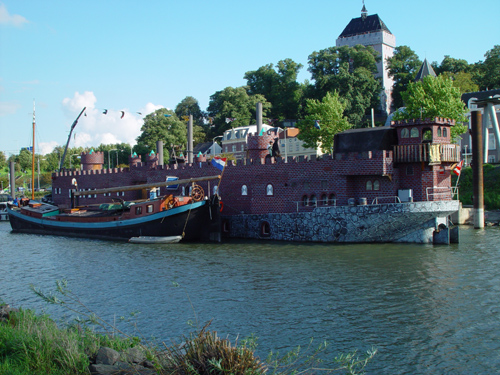| Dockings and Events |
|
| Museum Ship in Nijmegen starts on 26.08. till 30.09.2006 |
 |


History

Nijmegen celebrated its 2000 year existence in 2005. With its history going back to the 0's it is considered the oldest city in the Netherlands. In gaining this qualification, it has competed with the city of Maastricht.

The first mention of Nijmegen in history is in the 0s BC, when the Romans built a military camp on the place where Nijmegen was to appear; the location had great strategic value because of the surrounding hills, which gave (and give) a good view over the Waal and Rhine valley.

By 69, when the Batavians, the original inhabitants of the Rhine and Maas valley, revolted, a village called Oppidum Batavorum had formed near the Roman camp. This village was destroyed in the revolt, but when the revolt had ended, the Romans built another, bigger camp, where the Legio X Gemina was stationed. Soon after, another village formed around this camp.

In 103, the X Gemina was removed to Vienna, which may have been a major blow to the economy of the village around its camp. In 104, Emperor Trajan renamed the town, which now became known as Ulpia Noviomagus Batavorum. (The old theory that Nijmegen received market rights is incorrect.) Few Roman remains are visible today; a fragment of the old city wall can be seen near the casino, and the foundations of the amphitheatre are traced in the paving of the present-day Rembrandtstraat. However, the Valkhof museum has a large collection of Roman artifacts that have been dug up over the ages.

In the 4th century, Roman power decreased and Nijmegen became part of the Frankish kingdom. It has been contended that in the 8th century Emperor Charlemagne built a castle in Nijmegen.

Thanks to the Waal river, trade flourished and in 1230, Nijmegen was given city rights by Frederick II, Holy Roman Emperor. In 1247, the city was ceded to the count of Guelders as collateral for a loan. The loan was never repaid, and Nijmegen has been a part of Gelderland ever since. This did not hamper trade; Nijmegen even became part of the Hanseatic League in 1364.

The arts also flourished in this period. Famous medieval painters the Limbourg brothers were born and educated in Nijmegen.

During the Dutch Revolt, trade came to a halt and even though Nijmegen became a part of the Republic of United Provinces in 1585, it remained a border town and had to endure multiple sieges.

In 1678 Nijmegen was host to the negotiations between the European powers that aimed to put an end to the constant warfare that had ravaged the continent for years. The result was the Treaty of Nijmegen that, unfortunately, failed to provide for a lasting peace.

In the second half of the 19th century, the fortifications around the city became a major problem; there were too many inhabitants inside the walls, but the fortifications could not be demolished because Nijmegen was deemed as being of vital importance to the defence of the Netherlands. When, however, events in the Franco-Prussian war proved that old-fashioned fortifications were no more of use, this policy was changed and the fortifications were dismantled in 1874. The old castle had already been demolished in 1797, so that its bricks could be sold.

Nijmegen Waalbridge

A view over the center of Nijmegen in the wintertimeThrough the second half of the 19th century and the first half of the 20th century, Nijmegen grew steadily. The Waal was bridged in 1878 by a rail bridge and in 1936 by a car bridge, in 1923 the current Radboud University Nijmegen was founded and in 1927 a channel was dug between the Waal and Maas rivers.

In 1940, the Netherlands were invaded by Germany with Nijmegen being the first Dutch city to fall into German hands. On 22 February, 1944, Nijmegen was heavily bombed by American planes, causing great damage to the city centre. Allegedly the pilots thought they were bombing the German city of Kleve, although it has also been claimed to have been a deliberate act. The NIOD announced in January 2005 that its study of the incident confirmed that it was an accident caused by poor communications and chaos in the airspace. Over 750 people died in the incident. During 1944, the city saw heavy fighting during Operation Market Garden.

More recently, on February 23, 1981, the Nijmegen Police Department and the Dutch Army stormed the Piersonstraat and Zeigelhof, a squatted housing block in downtown Nijmegen. Using two hundred Riotvans, three Leopard MBTs, three armoured personnel carriers, a helicopter, twelve hundred policemen, and seven hundred fifty members of the armed forces, they evicted the squatters and demolished the block, while clouding the entire area in teargas and CS gas. This had an enormous backlash in local politics. While the city government wanted the squatters out to build a parking garage, most of the population wanted affordable housing to be built in the area.

As to this date Nijmegen is still known as Havana on the Waal among some Right-wingers. The Socialist Party, the Green Party and Labour have a solid two-third majority in City Council, making Nijmegen the only major city in The Netherlands with a solely Left-wing government. The current mayor is Mrs Dr Guusje Ter Horst.

In November 2005, downtown Nijmegen was the site of the assassination of political activist Louis Sévèke.

Location on google map
Source: http//:www.wikipedia.de |
|
 |
|
| |
|
|
| Events |
| Sorry, no entries available. |
|

